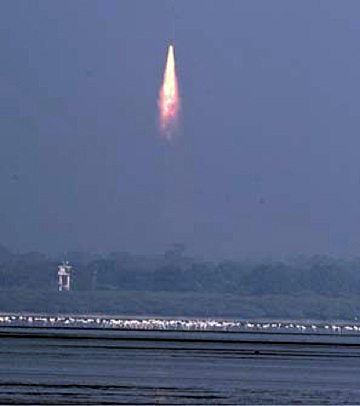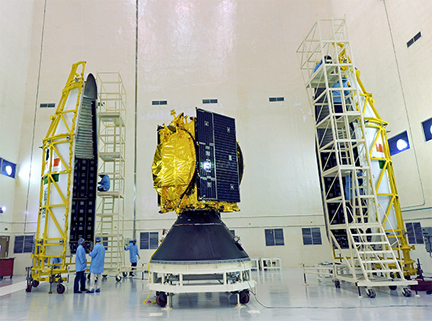[SatNews] A rocket propelled by a powerful indigenous engine took off smoothly carrying a communication satellite from Satish Dhawan Space Centre on Sunday, adding another feather in Indian Space Research Organisation’s (ISRO’s) cap after the successful launch of the country’s first Mars probe in November last year.

India's successfull launch of the rejuvenated indigenous cryogenic engine-fitted GSLV-D5, carrying communication satellite GSAT-14 at Sriharikota in Andra Pradesh.
Photo courtesy of PTI.
Precisely at 4:18 p.m. local time, the Geosynchronous Satellite Launch Vehicle - Development 5 (GSLV-D5) lifted off smoothly. The made-in-India cryogenic engine fired for 12 seconds and placed the 1,982kg GSAT-14 communication satellite into its orbit. The satellite will augment capacity via C- and Ku-band transponders. Vice-president Hamid Ansari, Prime Minister Manmohan Singh and Bharatiya Janata Party’s PM nominee Narendra Modi hailed the successful launch of the 414.75 ton heavy and 49.13 metre-tall rocket powered by an indigenous engine as an outstanding achievement. What’s more, the ISRO has finally cracked the cryogenic puzzle—until the launch, India was being helped by French rockets to place its communication satellites in orbit. However, now, the ISRO is the sixth space agency in the world, after the US, Russia, Japan, China and France, to have experienced the success with an indigenous cryogenic engine.
Last August, the launch of a GSLV rocket powered by an Indian cryogenic engine was called off a few minutes before scheduled launch time after a fuel leak was detected. In 2010, another GSLV rocket powered by a Russian cryogenic engine burst into flames just 63 seconds after liftoff. Scientists at Sriharikota were upbeat over the success of the indigenous cryogenic engine, which has been in the making for more than two decades and required an investment of around Rs. 400 crore. Now, India can save crores of foreign exchange, which the country used to spend as launching fees for satellites.

Two halves of the GSLV-D5 payload fairing surrounding GSAT-14 satellite.
Photo courtesy of the ISRO.
Isro chairperson K Radhakrishnan said the Indian cryogenic engine performed as predicted. "ISRO has done it. The Indian cryogenic engine performed as predicted and expected. We are extremely proud after three-and-a-half years of time we took to learn from our failures." He added later, "Today is an important day. India has a working cryogenic engine. GSLV can do its job as designed. We are now going for a series of GSLV vehicles to launch GSAT 6, GSAT 7, Chandrayan II and few more communication satellites of two-tonne class. We are also developing GSAT III which can take in more weights."
In another positive chapter in India’s space odyssey, the ISRO, in November of 2013, launched the Mars Orbiter Spacecraft, which was India's first interplanetary spacecraft, from Sriharikota. Only the US, Europe, and Russia have sent probes that have orbited or landed on Mars. Probes to the red planet have suffered a high failure rate and a success will be a boost for Indian national pride, especially after a similar mission by China failed to leave Earth’s orbit in 2011.
Sunday’s launch is India’s eighth flight of GSLV and also its fourth developmental flight. During this flight, the Cryogenic Upper Stage (CUS) was flight-tested for the second time. GSAT-14 is India’s 23rd geostationary communication satellite, as four of GSAT-14’s predecessors were launched by GSLV in 2001, 2003, 2004 and 2007.
(Source: Hindustan Times, KV Lakshmana)

